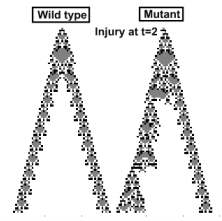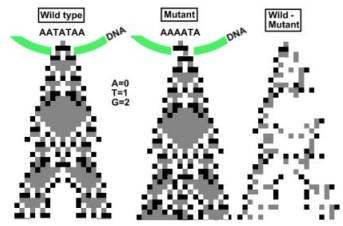 |
Knockout CA
 |
 |
The wild type DNA
consists of two genes represented by two gray squares. (T = 1). In the mutant CA the left gene was knocked
off . Despite this, both CA
remain somewhat similar. In order to depict their difference, mutant-CA
was subtracted from the wild type. Apparently the left border is more disturbed than the right.
The knockout technique is an
important tool for studying
gene function. The idea seems straight forward. You destroy a gene and examine the animal
(phenotype) for missing functions. These were exerted by the particular
gene before its destruction. Unfortunately in most (if not all) experiments,
this logic fails. It
presumes that there exists a simple mapping from genotype to phenotype.
Yet the mapping is non linear and extremely complex, since gene function
depends on the context in which it exists.
Each CA-state represents such a context and the effect of the knocked off gene varies from state to state. Obviously there is no simple (linear) mapping between the missing gene and the different CA states. The effect of a gene is propagated from state to state in an unpredictable fashion.
Suppressor geneThe experiment illustrates how molecular biology conceives cancer formation. The two (T =1), genes might be two alleles. When both exist, the CA has two normal tails. When one is missing, one tail becomes a tumor. A mutation or loss of a single allele ends in a tumor. Since tumor appears when one allele is missing, it appears as if the allele suppresses its formation,, and is called suppressor gene. However since a simple linear mapping between gene and phenotype does not exist, such a logic is wrong. The missing gene or allele does not suppress a pathology, rather it induces a now situation, which is neither normal or abnormal (more on the normal v. Chapter 29
Setup